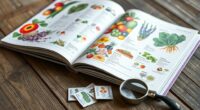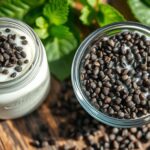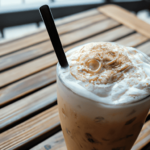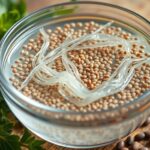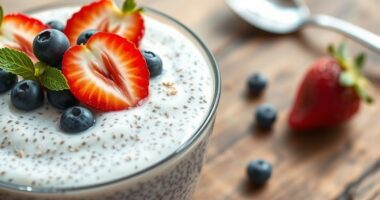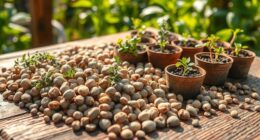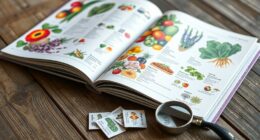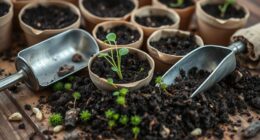To rebuild your gut flora after antibiotics, include probiotic-rich foods like yogurt, kefir, or sauerkraut, combined with fiber-packed ingredients like chia seeds. Chia’s fibers nourish beneficial bacteria and support digestion, while probiotics introduce fresh bacteria to restore balance. Combining these foods creates a synergy that speeds up recovery and improves gut health. Keep up this routine consistently, and you’ll discover more tips that help your gut thrive again.
Key Takeaways
- Incorporate probiotic-rich foods like yogurt, kefir, sauerkraut, and kimchi to restore beneficial gut bacteria after antibiotics.
- Add chia seeds to meals for fiber that nourishes existing beneficial bacteria and promotes gut microbial diversity.
- Combine probiotics with fiber-rich chia seeds to create a synergistic effect, accelerating gut flora recovery.
- Regularly consume probiotic foods and chia seed meals to support long-term gut health and resilience.
- Maintain hydration to aid fiber movement and optimize probiotic activity during gut rebuilding post-antibiotics.
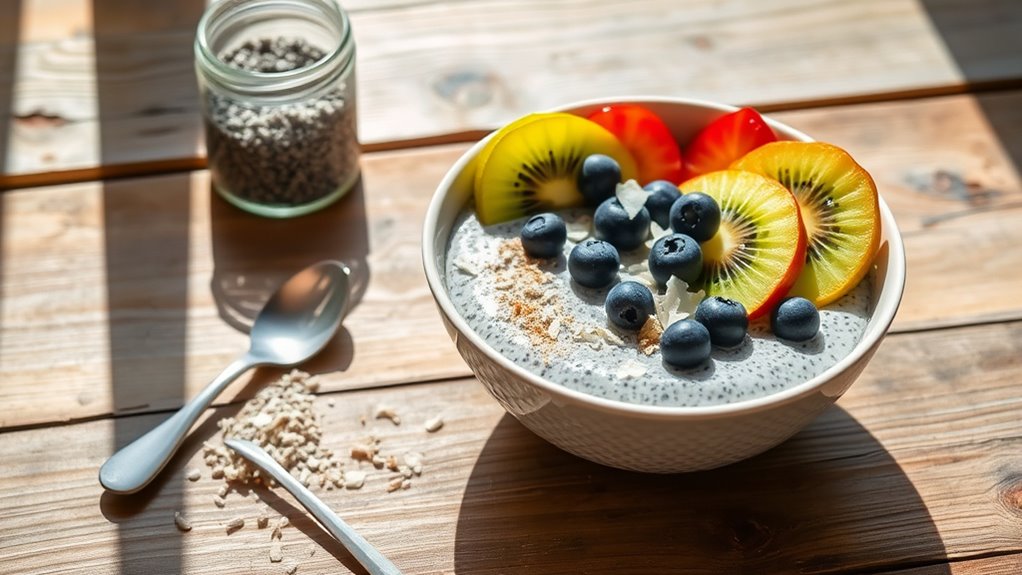
After completing a course of antibiotics, your body begins the essential process of recovery. Antibiotics can disrupt the delicate balance of your gut microbiome, killing off both harmful and beneficial bacteria. To help restore this balance, incorporating probiotic foods into your diet is vital. These foods are rich in live beneficial bacteria that can repopulate your gut, aiding in digestion and strengthening your immune system. Yogurt, kefir, sauerkraut, and kimchi are excellent options to start with. Consuming these regularly can introduce a diverse array of probiotics, helping your gut recover faster and more effectively.
Rebuild your gut with probiotic foods like yogurt, kefir, sauerkraut, and kimchi for faster recovery.
Alongside probiotic foods, focusing on dietary fibers plays an imperative role in rebuilding your gut flora. Dietary fibers serve as nourishment for the beneficial bacteria already present in your intestines. When you increase your intake of fiber-rich foods, you create an environment that supports the growth and diversity of healthy bacteria. Chia seeds, in particular, are a fantastic source of dietary fibers. They contain both soluble and insoluble fibers, which help bulk up stool, promote regular bowel movements, and foster a thriving microbial community. Adding chia seeds to your meals—whether in smoothies, oatmeal, or yogurt—can provide a gentle and sustained source of fiber that your gut bacteria love.
The combination of probiotic foods and high-fiber meals like those with chia seeds creates a powerful synergy. Probiotics introduce new beneficial bacteria, while dietary fibers provide the fuel they need to flourish. This duo accelerates the rebalancing of your gut flora, reducing symptoms like bloating, gas, or irregularity that often follow antibiotic treatment. Remember, high-quality probiotics and consistency are key. Incorporate probiotic foods daily and include fiber-rich ingredients like chia seeds into your diet. It’s also helpful to stay hydrated, as water supports the movement of fibers and the activity of probiotics through your digestive system.
Over time, this approach helps your gut regain its natural diversity and resilience. Rebuilding your gut flora isn’t just about immediate relief—it’s about establishing long-term health. By making mindful food choices that emphasize probiotic foods and dietary fibers, you support your body’s natural ability to recover and maintain a healthy microbiome. This proactive step can markedly improve your overall well-being, energy levels, and immune response, ensuring your digestive health stays robust long after your antibiotics course ends.
Frequently Asked Questions
Can Chia Seeds Replace Probiotics During Recovery?
You might wonder if chia seeds can replace probiotics during recovery. While chia seeds aren’t direct probiotic alternatives, they offer natural gut support by providing fiber that feeds beneficial bacteria. Incorporating chia seeds can complement your recovery plan, but don’t rely on them alone. For ideal gut health, combine chia seeds with other probiotic sources or supplements, ensuring a balanced approach to rebuilding your gut flora after antibiotics.
How Long Does Gut Flora Typically Take to Recover?
Your gut flora typically takes a few weeks to several months to recover, depending on factors like microbiome diversity and overall health. During this time, implementing dietary interventions such as fiber-rich foods, including chia seeds, can support microbiome diversity and promote faster recovery. Consuming a variety of nutrient-dense foods helps restore gut balance, but patience is key as your microbiome gradually reestablishes its healthy microbial community.
Are There Any Side Effects of Consuming Chia Seeds Post-Antibiotics?
Ever wonder if chia seeds could have hidden side effects? While their antioxidant properties and high fiber content generally promote gut health, some may experience bloating or allergic reactions. Consuming chia seeds after antibiotics might cause temporary digestive discomfort or interfere with medication absorption. Stay cautious, introduce them gradually, and always listen to your body. Consulting a healthcare professional guarantees you’re making safe, informed choices for your gut’s recovery.
Should Chia Seeds Be Avoided if Experiencing Digestive Issues?
If you’re experiencing digestive issues, you might wonder if chia seeds should be avoided. Typically, if you have digestive sensitivity or seed allergies, it’s best to steer clear of chia seeds to prevent discomfort or allergic reactions. However, if your digestion is generally healthy, chia seeds can help rebuild gut flora after antibiotics. Always listen to your body and consult a healthcare professional if you’re unsure about including chia seeds in your diet.
Can Chia Seed Meals Help Prevent Future Gut Imbalances?
Chia seed meals can help prevent future gut imbalances by adding a fiber variety to your diet, which promotes healthy bacteria. To maximize benefits, guarantee proper seed preparation, like soaking or grinding, to improve digestibility. Including chia seeds regularly supports gut health, but balance them with other fiber sources. This approach helps maintain diverse gut flora and reduces the risk of imbalances over time.
Conclusion
Just as a garden regrows after a storm, your gut flora can flourish again with the right care. Incorporate chia seeds into your meals to nourish and rebuild your microbiome, restoring balance and resilience. Think of it as planting seeds of health, waiting patiently for vibrant blooms of energy to emerge. With consistency and patience, you’ll find your inner ecosystem thriving once more, like a forest reborn after the rain.

